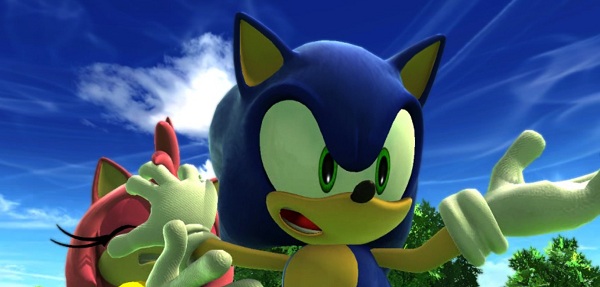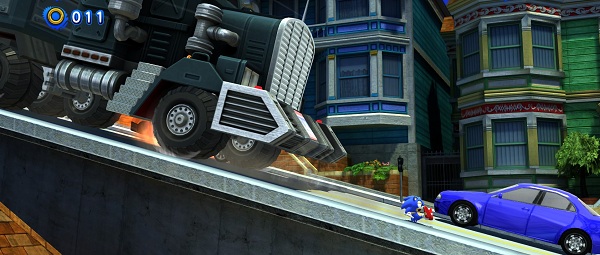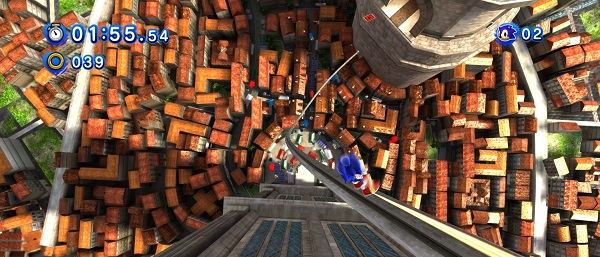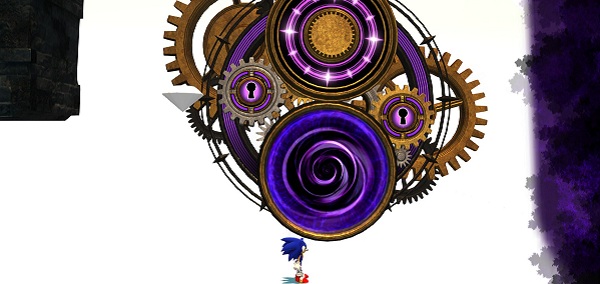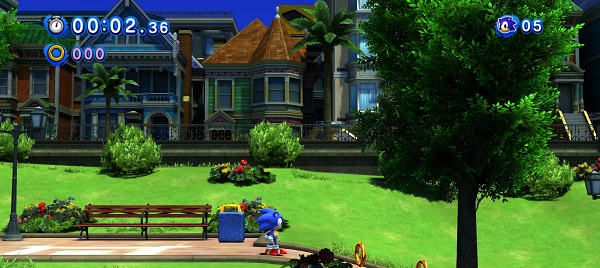Wot I Think: Sonic Generations
Two Blue
In Sonic Generations, the unnatural hedgehog meets his younger, pot-bellied self as Sega attempts to show that it can recapture its old magic, while proving that there’s a place for its blue mascot in the modern world. As the slowest creature on two legs, who dreams nightly of great athletic feats, I am the ideal choice to tell you wot I think of the blue speedster's latest.
The many failures of Sonic’s 3D adventures have a well-documented history, which culminated in the open and violent message board mockery of anyone daring to anticipate a new release. All of the internet had decreed that if a man were to state that the new Sonic game looked like “a return to form” or “a passably entertaining experience”, he could legally be duffed around the head with shovels made out of words and animated gifs of the Sega logo dry humping his wallet and weeing on his childhood. For the good of all, those times are over.
Sonic Colours helped make reparations. I haven’t played it so I don’t know if the warm reception was deserved or not but the modern sections of Sonic Generations have a lot in common with Colours, so I feel comfortable in saying at least some degree of warmth was deserved. You see, Sonic Generations really is rather good. The modern bits and the not-so modern bits alike, even if the not-so modern bits are more modern than I was expecting, with their snazzy graphics and hyperactive camera.
But enough of this! To explain all this talk of modernity I’m going to have to talk about the plot, which is absolutely the worst part of the game. It shouldn’t have a plot, it doesn’t need a plot. It doesn’t need stupid dialogue and horribly cloying voices, it doesn’t need loads of characters that look like they come from the mind of a child from the early nineties who thought that a crocodile in a leather jacket on a skateboard would be totally the most awesome thing. In fact, Generations was the perfect chance to jettison all sense of narrative and instead have a front-end that is unashamedly a collection of levels with no reason to throw them together other than the fact they’re all part of Sonic’s past.
That would work. Make it a multimedia interactive museum, which is what it comes down to in the end, but please don’t string it together with a silly story. Except my pleas and commands are pointless because they already have and I’ve already experienced it so I’ll make the summary short. A horrid shadow creature smashes a picnic that Sonic and his friends are about to enjoy and two timelines become intertwined. One is the time of 2D sidescrolling, which was Sonic’s classical age, the other is the time of 3D running-into-the-screen, which has threatened to be Sonic’s Great Depression.
The world is cleansed of colour, though only in the hub, and the Sonics must travel through, restoring it to life by running really really fast, grinding on rails and bouncing off badniks. Completing each Act with both Sonics, which means in both playstyles, restores a character to life. It’s a shame, because it feels like being punished as soon as they open their anthropomorphic faces and start complimenting Sonic’s radicalitude or, in the darkest moments, flirting with him.
Bugger all that though because everything in between is brilliantly entertaining and I do mean brilliantly. It’s not just a shock of rainbows, with Sonic travelling through sky, sea and fire in time-honoured platforming tradition. Visually, it’s one of the most appealing games I’ve played in a while, not just in its multihued aesthetic but in the variety of environments on show. Green hills and blue skies feature largely, of course, as do killer whales that miss no opportunity to arch overhead, but there are ruins and post-apocalyptic cities to dash through as well.
The most memorable moments are the quieter ones, when the strange juxtaposition of a bouncing, beeping blue hedgehog in a realistic setting hammer home Sega’s inventive streak. The Rooftop Run zone is a place I’d like to spend more time, with its European-styled city backdrop evoking Assassin’s Creed of all things, as Sonic speeds through narrow streets, and across towers and spires. Coming to a screeching halt by a beautifully realised roadside café, with pigeons pecking around in the street, is a delight.
It’s not all zipping about at a staggering rate of knots, you see. There’s time to slow down and perform more careful jumping and even some exploration. The sense of discovery is boosted by the impressive number of alternate routes through each act, in both the traditional and modern modes. When I first played those modern levels, which are often more akin to racing than platforming, I was ready to dismiss them harshly as little more than barely interactive cutscenes. There’s so much happening, with entire cities collapsing behind the scampering red shoes and bumpers directing him through the air that it starts to feel like a non-interactive spectacle.
But I retract my harsh dismissal before it is made. The more I played, the more obvious it became that while bouncing from bumpers around may leave Sonic in the hands of physics and fate, the path he takes in between those directed sections is entirely down to the player’s skill. Miss a fast-approaching jump and you’ll fall to another track, from which you can often fall again to a new path, each slower or more hazardous than the last.
All of these multi-route shenanigans become more impressive when they reveal the connected nature of the zones. They often play like a series of set pieces in environments that are more eye candy than physical space, but fall off the beaten path and you’ll often see the route you could be taking as it snakes overhead, corkscrewing tauntingly into the blue yonder. Manage to stick to that route on another attempt and you might just glimpse the dingy undergrowth you were dragging yourself through below, a fleeting glimpse as you sprint, upside-down, defying gravity and previous high scores with high-flying abandon.
When the game hits its stride and you feel its flow, it’s a hugely rewarding experience. And that’s most of the time. But it sure does know how to frustrate. Modern Sonic’s attack, activated by hitting the ‘A’ button (I played with a 360 controller, can’t imagine it working too well without some form of pad), homes in on the nearest enemy and uses them as a springboard. When it works, it’s great, allowing him to pop enemies, skipping across enormous gaps all the while. Unfortunately, the same button also triggers a mid-air dash, which can be used to redirect mid-flight or to make up for a failed jump and reach a platform otherwise out of reach. Attempt that when there’s an enemy nearby and Sonic might head for that instead, often taking him backwards, into the void, leading to a life lost.
It’s a failing of the lock-on system in general rather than Generations and it’s one of the ‘advances’ that has annoyed in 3D Sonic games before. It’s probably better here than it ever has been and those unfair deaths are few, although they happened to me repeatedly in a few places, which either means I don’t learn from my mistakes and was effectively walking into the same glass patio door repeatedly, or there are a few poorly designed sections.
I could also do without the upgrades that can be purchased. I’d rather my ability to achieve impressive times relied on my improving skills rather than purchased perks. Some are designed to allow different kinds of navigation, which I can understand, but on the whole I ignored them. Maybe if I was trying to unlock everything and beat every time, I’d delve into them and find them more useful, but it seems an unnecessary distraction. I could be wrong.
But, yes, modern Sonic has won me over, though I find old Sonic much more fun and he doesn’t lose much of the flashiness of his leaner counterpart. The camera still pans around to show the action to its best advantage and there’s plenty of stuff to smash, as well as devices to propel and pummel tubby Sonic. The game actually claims that the old-style levels are easier but I would describe them as more contemplative. They slow down more often and alternate routes are easier to spot – mainly because they don’t flash by in the blink of an eye.
The most important that Generations offers is an intelligent understanding of how to make Sonic move. It might seem obvious – he moves fast and to the right, or into the screen depending which time he’s from – but momentum is far more important to Sonic than speed. Yes, he goes fast, that’s kind of his thing, just like murdering animals and wearing their butchered hides is Mario’s thing. But despite his spindash, which allows him to build speed on the spot, Sonic relies on clever use of physics to traverse levels smoothly. Inclines can be used to perform angled jumps, steep hills grant a speed boost or bring him grinding to a halt, and the people with the best times will be those who master the intricacies of the physics, not just those who learn the levels by heart.
In terms of content, there are nine zones from across Sonic’s history, each of which provides the Sonics with an Act each. Once those are done, there are challenges, ranging from time trials to races and treasure hunts, which further explore the zones. Most of these unlock artwork and music, but some need to be completed in order to collect boss keys, which lead to impressive fights that allow progression to the next set of zones.
There’s plenty to do. I rushed through but it would be easy, if somewhat contrary, to take things slow and explore each zone fully. The incentive to repeat areas is aided by times flashing up on screen at each checkpoint, letting you know how far off your best you are and urging you to improve. It’d be great if this could track friends’ times through Steam as well, but sadly that’s not the case. There is an online ranking mode but it’s accessed from the root menu, rather than being integrated with the game proper. Shame.
Other than that, there’s little to complain about in the PC version as I experienced it. No slowdown, no skipping and beautiful graphics. There’s an unfortunate lack of graphical options but the game looks lovely and I never felt the need to fiddle around.
I haven’t followed Sonic closely over the years, but for anyone who has there’s an embarrassment of riches here. The reimagined stages are no doubt full of references and allusions, and the quantity of unlockable bits and pieces is impressive. It has indeed taken them ages, but Sega have delivered a game worthy of their mascot, who has endured thin times and his share of sickness.

